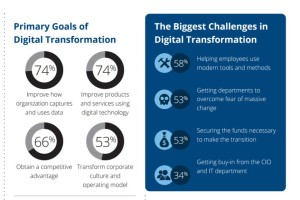The majority (56%) of IT professionals surveyed by SADA said their organizations spent at least one million dollars on a company-wide digital transformation, but only 18% said the money had been allocated to “change management”
SADA Systems recently conducted an online, digital transformation survey asking more than 350 IT professionals what worked and what didn’t as their organizations adopted and implemented digital technology tools and modern operational methods. A key takeaway was that while digital transformation was an “extremely high” priority (49 percent), many transformations suffered from poor internal communication, education and training.
Enterprise organizations are looking at digital transformation – defined as the integration of modern technology into all areas of business, resulting in fundamental changes to corporate culture, operations and product/service delivery – as the key to innovation and growth. But change, no matter how advantageous, is neither easy nor inexpensive. According to Gartner, through 2019, every $1 enterprises invest in innovation will require an additional $7 in core execution. That means companies must be willing to commit to the kind of heavy lifting “change management” activities that are required to ensure a smooth and successful transition. However, this doesn’t always happen.
According to IT professionals polled by SADA, more than a quarter (27 percent) said their digital transformations would have gone better had their organizations focused more on ensuring communication between IT staff and employees. Another 22 percent said there should have been better training and education of employees, and 14 percent complained about a lack of technical support for the use of new digital tools and operational methods.
Meanwhile, 53 percent of IT professionals surveyed said their biggest challenge in completing a digital transformation was getting non-IT departments to overcome a fear of “massive change,” and 57 percent said their biggest challenge was helping employees use modern tools and methods. While most IT professionals polled said their organizations spent upwards of one million dollars on digital transformation, more than half (53 percent) noted that they had trouble securing the funds necessary to make the transition properly.
Given these issues it’s perhaps not surprising that IT departments haven’t been completely satisfied by their organizations’ digital transformations. Per the survey results, IT was the department least satisfied by the transformation (23 percent); Finance was equally unsatisfied. These groups cited a lack of training to support the transition (31 percent) as the primary reason for their limited satisfaction. The next most common reason was they didn’t want to make the transition in the first place (27 percent).

Other important takeaways from the SADA Systems 2016 Digital Transformation Survey:
- Despite the various objections and complaints, 93 percent of survey respondents said their organization’s digital transformation was successful
- The most commonly cited goals (74 percent) for making the transformation were to improve the way their organizations capture and use data, and to improve the products and services they offer using digital technologies
- According to the survey, the CEO was the most common executive sponsor of the digital transformation (46 percent of cases), followed by the CIO (19 percent)
- 46 percent of survey respondents said IT should lead a company’s digital transformation and also take responsibility for training and adoption, while 44 percent said IT should lead but allow Line of Business to handle the implementation
- 37 percent of respondents said their projects began 1-3 years ago, while 33 percent said they started 3-5 years ago, and 17 percent started within the past year
- 34 percent of respondents said the majority of money allocated to digital transformation was spent on new technology tools, and 31 percent of IT professionals said the majority was spent on technology integration projects
- 30 percent of respondents said their digital transformation took 3-6 months to complete, 24 percent said it took 7-9 months, and 19 percent said it took 10-12 months
- 30 percent of respondents said a successful digital transformation would be defined as “the project’s overall cost would be easily paid off through efficiency and net new profit due to modernization”
- 19 percent of respondents selected cloud infrastructure as the cornerstone of their digital transformation initiative, while 15 percent said it was Big Data or analytics technologies and 14 percent claimed the key tech tools were social media
“We are constantly talking to our customers about the importance of user experience and change management,” says Tom Marek, Practice Director for the Microsoft Enterprise Solutions group at SADA Systems. “Every hour put in up front on design and usability will result in a much easier transformation. Digital transitions are too expensive, time-consuming and important to be left to chance. Companies must constantly work with employees to help them understand and use new tools and methods. This isn’t the sexiest part of the transition, but nothing matters more in terms of a positive outcome.”



